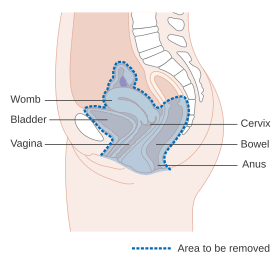Pelvic exenteration
| Pelvic exenteration | |
|---|---|
 Diagram showing the area removed in a pelvic exenteration in a female | |
| Other names | Pelvic evisceration |
| ICD-9-CM | 68.8 |
| MeSH | D010385 |
Pelvic exenteration (or pelvic evisceration) is a radical surgical treatment that removes all organs from a person's pelvic cavity. The urinary bladder, urethra, rectum, and anus are removed.
The procedure leaves the person with a permanent colostomy and urinary diversion. In women, the vagina, cervix, uterus, fallopian tubes, ovaries and, in some cases, the vulva are removed. In men, the prostate is removed.
Indications
Pelvic exenteration is an option in cases of very advanced or recurrent cancer, for which less radical surgical options are not technically possible or would not be sufficient to remove all the tumor. This procedure is performed for several types of cancer including genitourinary and colorectal cancers.[1]
A 2015 article reports that pelvic exenteration can provide long-term survival for patients with locally advanced primary rectal carcinoma. The 5-year survival rate of patients undergoing pelvic exenteration following complete resection of disease was 59.3%. Factors shown to influence the survival rate following a pelvic exenteration procedure include age, the presence of metastatic disease, lymph node status, circumferential resection margin, local recurrence of disease, and the need for neoadjuvant therapy.[2]
Complications
After pelvic exenteration, many patients will have perineal hernia, often without symptoms, but only 3–10% will have perineal hernia requiring surgical repair.[3]
History
The procedure was first described by Alexander Brunschwig in 1948.[4][5]
References
- ^ "Palliative pelvic exenteration: A systematic review of patient-centered outcomes". European Journal of Surgical Oncology : the Journal of the European Society of Surgical Oncology and the British Association of Surgical Oncology. 45 (10): 1787–1795. October 2019. doi:10.1016/j.ejso.2019.06.011. PMID 31255441.
- ^ Radwan RW, Jones HG, Rawat N, Davies M, Evans MD, Harris DA, Beynon J (September 2015). "Determinants of survival following pelvic exenteration for primary rectal cancer". The British Journal of Surgery. 102 (10): 1278–84. doi:10.1002/bjs.9841. PMID 26095525.
- ^ Krasiuk BM, Gorelova EM (August 1990). "[Non-parasitic cyst of the spleen in a child]". Khirurgiia (in Russian) (8): 130–1. PMID 2259151.
- ^ Brunschwig A: Complete excision of the pelvic viscera for advanced carcinoma. Cancer 1948; 1: 177.
- ^ med/3332 at eMedicine
